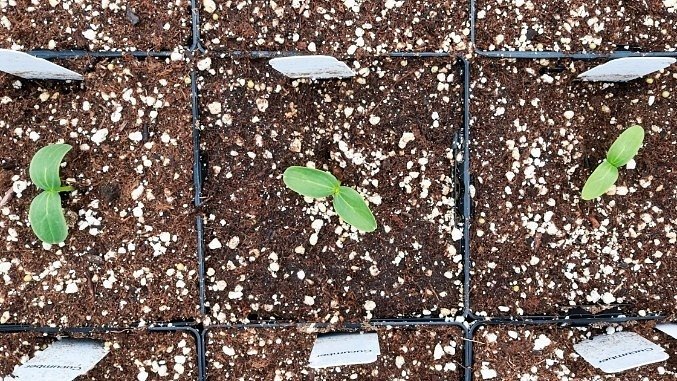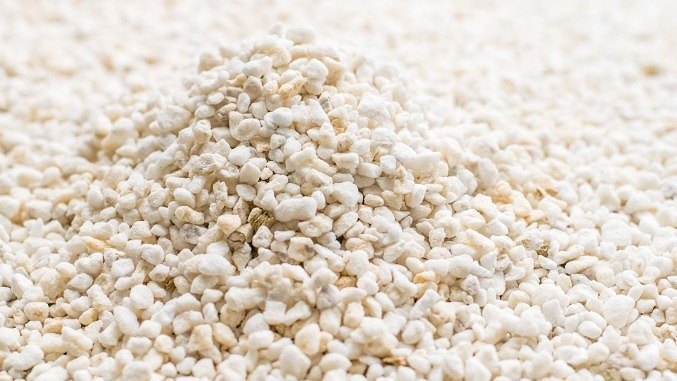
Perlite - How useful it can be in your Gardening Job!
7 Minute Read
The distinguishing feature that sets perlite apart from other volcanic glasses is that when heated to a suitable point in its softening range, it expands from four to twenty times its original volume. Perlite speeds up the germination and rooting, improves aeration, draining & insulation in Potting Mixes and improves the texture of clay soils.Perlite is the name for a naturally occurring siliceous rock. When heated, it has the capacity to expand from four to twenty times its original volume. This is due to the rapid expansion of water within perlite, which creates the extremely light perlite that we use for gardening.
The main function of perlite for the gardener is to aid water retention and aeration as well as improve compost mixtures.
Perlite is mined and expanded all over the world. The United States is estimated to be the largest consumer and producer of both crude and expanded perlite. However, other countries producing perlite include China, Greece, Japan, Mexico, Hungary, Armenia, Italy and Japan.
Benefits
The main function of perlite for the gardener is to aid water retention and aeration as well as improve compost mixtures.
Perlite is mined and expanded all over the world. The United States is estimated to be the largest consumer and producer of both crude and expanded perlite. However, other countries producing perlite include China, Greece, Japan, Mexico, Hungary, Armenia, Italy and Japan.
Benefits
- Prevents compaction
- Improves aeration and drainage better than vermiculite
- Stimulates root initiation and vigorous growth
- Holds moisture but does not become soggy
- Almost neutral pH
- Does not decompose
- Free from disease, weeds and insects
- Insulates and minimises temperature fluctuations
- Inorganic, inert and sterile
- No known toxicity or fire hazard

Seed Germination
Perlite speeds up germination and improves seedling growth.
For seeds, sow on a well-watered mixture of equal parts perlite and Sphagnum Moss Peat. Alternatively, add 1 part perlite to 2 parts ready-mixed potting compost.
For use pure, keep wet at all times by capillary irrigation or intermittent mist. After sowing, sprinkle seeds with a thin layer of fine peat and cover with glass or plastic to retain moisture until germination, then feed
Potting Mixes
Perlite is used in potting compost mixes to improves aeration, draining and insulation. Perlite can be used to open up the structure of ready-mixed loam or peat-based composts.
For soilless compost mixtures, use 3 or 4 parts of Sphagnum Moss Peat to 1 part of perlite (80/20).
For loam-based compost mixtures, use equal parts sterilised loam, peat and perlite (1:1:1) plus limestone and nutrients. Alternatively, a 1:2:1 mix may be used. Mix thoroughly, then water well after planting and feed as appropriate.
Rooting and Cuttings
Perlite speeds uprooting, reduces the risk of damping off, provides an optimum balance of air and water, and makes water logging almost impossible. It also minimises damage to roots and growth disruption from transplanting.
For soft stem and leaf cuttings, use a mixture of equal parts perlite and Sphagnum Moss Peat (50/50). For harder cuttings and fragile plants, increase the proportion of perlite up to 4 parts perlite to 1 part peat (80/20).
For mist irrigation, perlite may be used 100% where sterility is essential. Keep well-watered but ensure free drainage. Feed plants as soon as roots develop.
Soil Conditioning
Perlite improves the texture of heavy silt or clay soils by increasing aeration and drainage. It also minimises the tendency to 'cap' over germinating seeds. These improvements will last for many years.
For difficult seedbeds and flower beds, use up to 25% perlite worked into the top 5-10cm before sowing.
For trees, shrubs and roses, mix perlite with the soil when backfilling the planting hole to stimulate root growth.
Turf Dressing
Because Perlite improves aeration and drainage, it will assist the air-moisture balance and ensure better root development and turf growth. Golf course greens treated with perlite will show improved resilience and greater tolerance in use under extreme weather conditions - wet or dry.
For compacted and poorly drained areas on old turf and for the establishment of new turf, use as follows: Spike over the affected area with a hollow tine then spread a thin layer (2-5mm) of damp perlite pre-mixed with a suitable fertiliser. Rake or brush evenly, and water thoroughly. Note: a 100-litre bag of perlite will give on average a 2mm layer over 50sqm.
Capillary Watering, NFT & Hydroponics
Perlite is an inert, sterile, neutral, ultra-lightweight aggregate with a very high air and water-holding capacity. To sterilise perlite for re-use, steam, flame-gun or treat with any proprietary chemical steriliser.
For capillary watering use, allow at least 25mm (1 inch) depth of perlite in place of sand or gravel in polythene-lined benches or suitable trays.
For ring culture and low-cost commercial production of tomatoes, use perlite in polythene lined trench or channel, and saturate with nutrient solution.
Special Note:
With electrical heating cables use a 50/50 mix of perlite and sand to prevent overheating.


Horticultural Medium Grade Perlite 100lt Silvaperl
Perlite is a generic term for a naturally occurring siliceous rock. The distinguishing feature that sets perlite apart from other volcanic glasses is that when heated to a suitable point in its softening range, it expands from four to twenty times its original volume.find out more

Westland Gro-Sure Perlite 10 Litre
This naturally occurring volcanic rock has been heated to high temperatures to produce lightweight, micro-porous granules. This is perfect for improving aeration, moisture retention and drainageComments (4)
Leave A Comment
Most popular articles
1
Plastic plant pots dimensions and uses2
Peat vs Peat Free - Choosing the right Potting Compost3
How to Grow Watercress at home in plant pots4
January Jobs5
March Jobs
Reply